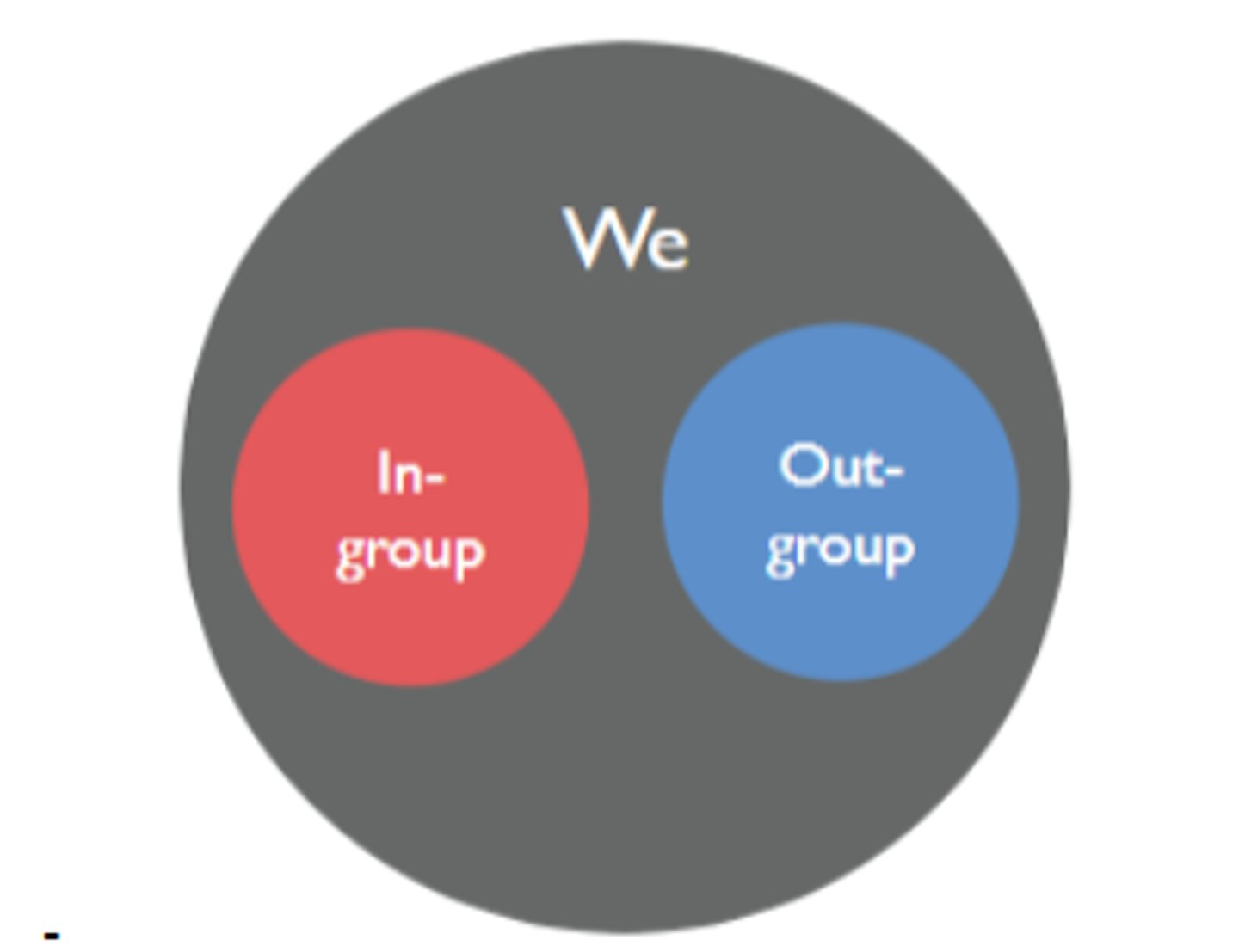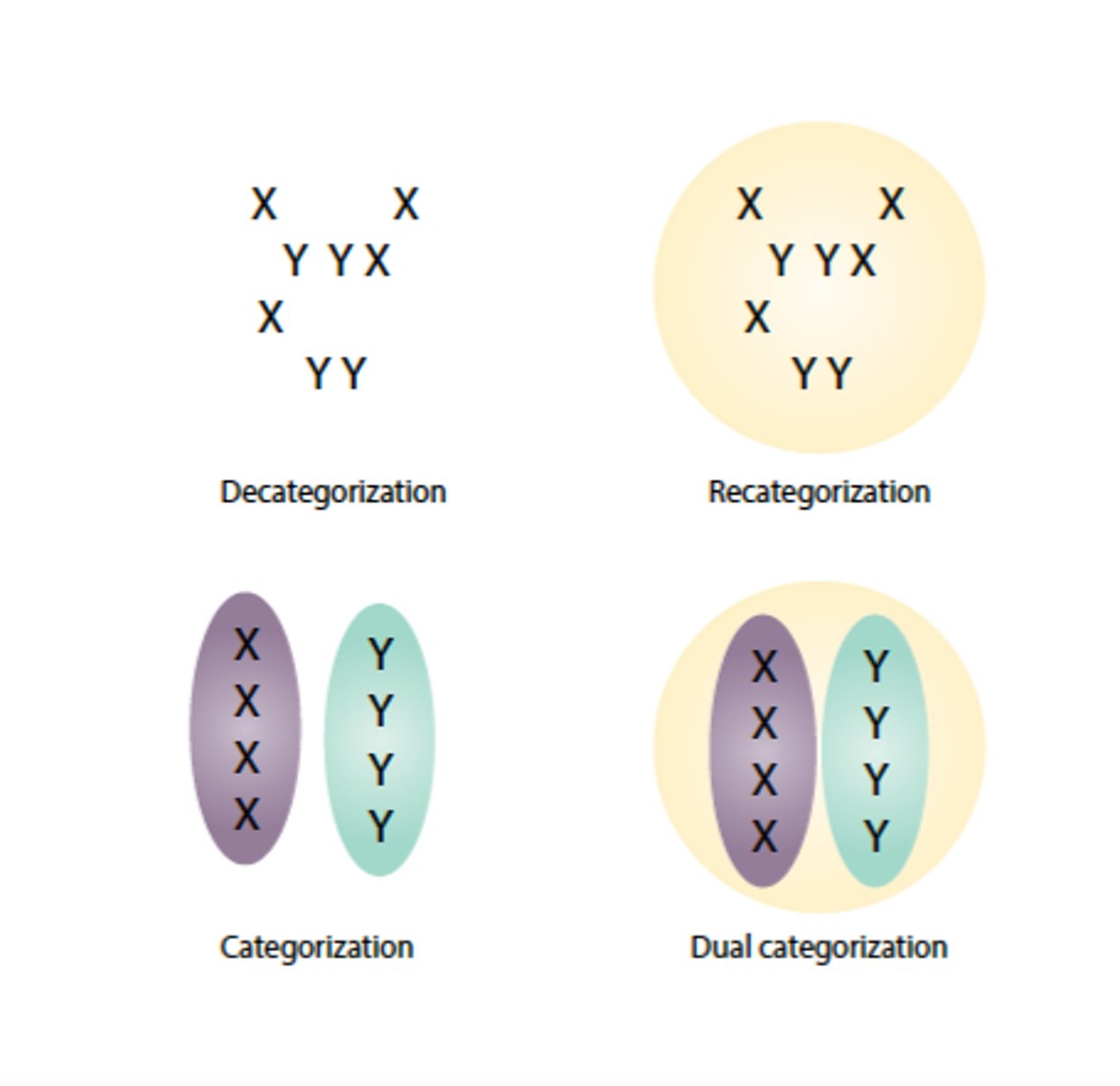2. stereotyping, prejudice and discrimination
1/79
There's no tags or description
Looks like no tags are added yet.
Name | Mastery | Learn | Test | Matching | Spaced |
|---|
No study sessions yet.
80 Terms
Stereotyping
A cognitive process that involves assigning characteristics to individuals based on their group membership.
Prejudice
An unfavorable opinion or feeling formed beforehand or without knowledge, thought, or reason, often directed towards a group.
Discrimination
The unjust or prejudicial treatment of different categories of people, often based on race, age, or sex.
socio-cultural approaches to prejudice
stereotyping and prejudice and group conflict based on the idea that the origins emerge based on relations between groups
Realistic Conflict Theory
A theory that argues prejudice and intergroup aggression are caused primarily by competition for scarce resources.
who developed realistic conflict theory
sherif
Boys' Camp Studies
Field experiments conducted in the 1950s that examined group dynamics and intergroup conflict among middle-class Caucasian boys.
Mutually Exclusive Goals
Goals that cannot be achieved simultaneously by different groups, that reduces conflict
prejudice from an intergroup perspective
"Prejudice" as an intergroup attitude is meaningful and functional, it follows people's understanding of the intergroup relationship (co-operative or conflictual).
critique of socio-cultural approaches
-Stereotypes (and prejudice) emerge and shift based on context
-Approach more descriptive than explanatory (it doesn't tell us much about what was going on in people's heads)
-Analysis of psychological process remains unclear
-Solutions realistic?
Contextual Shifts in Stereotypes
The idea that stereotypes and prejudices can change based on the social context.
Ethnocentrism
The belief in the superiority of one's own ethnic group, often resulting in prejudice against other groups.
Psychodynamic Theories
Theories that suggest personality and behavior are influenced by unconscious motives and conflicts.
Frustration-Aggression Hypothesis
Aggression (and prejudice) arises when goal pursuit is blocked; aggression displaced onto less powerful outgroups ('scapegoating').
critique of Frustration-Aggression Hypothesis
-Difficult to predict the target of aggression
-Frustration neither necessary nor sufficient to cause aggression
Miller & Bugelski Experiment
An experiment that showed participants who experienced frustration developed more negative attitudes towards minority groups.
Berkowitz's Reformulation
A refinement of the frustration-aggression hypothesis that examines the conditions under which frustration leads to aggression; the perception of deprivation is more important than actual deprivation.
prejudiced personality
A personality type characterized by rejection of outgroups, often linked to early harsh experiences and insecurity
authoritarian personality
A personality syndrome proposed to be related to prejudice, characterized by rigid adherence to conventional values.
prejudiced personality comes from
-punitive and harsh early life experiences
-Insecurity
-Fearfulness
-Inability to cope with inner tensions or conflicts
-Inability to cope with uncertainty, change and ambiguity in the external world
Tolerant Personality
A personality type resulting from permissive parenting, characterized by security, maturity, and inner confidence.
tolerant personality comes from
-permissive parenting and unconditional acceptance
-Security
-Maturity
-qInner confidence and ability to cope with threat and uncertainty
Authoritarian Personality
A personality characterized by rigid adherence to values, submission to authority, and generalized hostility.
authoritarian personality is characterized by
-rigid adherence to conventional values
-an exaggerated need to submit to, and identify with, strong authority
-anti-intraception (dislike for sensitivity or tender-mindedness)
-generalized hostility
-a mystical, superstitious cast of mind
-stereotyped thinking and a tendency to represent the world as 'black and white'
Right-Wing Authoritarianism
A personality construct with three dimensions: authoritarian submission, authoritarian aggression, and conventionalism.
authoritarian submission
high degree of submission to legitimate authority
Authoritarian aggression
General aggressiveness towards various groups seen to be encouraged by the social or political order of the day
conventionalism
High adherence to social conventions as endorsed by society or established authority
example of right-wing authoritarianism
"Our country will be great if we honour the ways of our forefathers, do what the authorities tell us to do, and get rid of the 'rotten apples' who are ruining everything."
Criticisms of RWA
Overfocus on personality misses collective/institutional prejudice and left/right spectrum nuances.
Field Studies on Aggression
Research showing that external factors like heat can influence the likelihood of aggressive behavior.
Sherif's studies indicate
even normal individuals can develop prejudicial beliefs in certain social situations.
Critique of Psycho-Dynamic/Personality Approaches
Criticism of theories that do not account for social norms or intergroup cooperation.
Cognitive limitations
The human mind has limited cognitive capacity, leading to oversimplification in social judgments.
Cognitive miser
The tendency to conserve cognitive resources by relying on mental shortcuts and generalizations.
stereotyping according to cognitive miser
Stereotyping is part of 'normal' or universal cognitive processes rather than 'abnormal' personalities and help us to understand what to expect from our surroundings - including other people
fiske and taylor 1984
View of humans as faulty information-processing devices; perception errors seen as result of limited processing capacity so people often forced to make decisions that are quick and easy (often wrong), rather than ones that are time-consuming and onerous (more often right)
Attributional errors
Mistakes in judgment due to a lack of mental resources to consider all factors involved.
critiques of the cognitive approach
-neglects the role that group membership and intergroup relations play in stereotyping
-Too focused on the potential need to save cognitive resources (e.g., attention)
-downplays the social and political aspects of stereotypes/prejudice: as expressions of group status, ideology and justifications of collective action
Tajfel (1969) definition of stereotypes
the attribution of general psychological characteristics to large human groups
tajfel and wilkes experiment
people assigned to blue B line exaggerated the difference between A and B and how B was similar to other B
key takeaway of tajfel and wilkes experiment
When people perceive there to be a correlation between a classification and a dimension of judgment they will 1. exaggerate the differences between the classes on that dimension 2. minimise the differences within the classes on that dimension because of stereotype accentuation
Socialization of stereotypes
The process through which stereotypes are learned and become relatively enduring.
Dominant explanations for prejudice origins
Factors such as competition over scarce resources, existing hostilities, history of negativity, and personality that contribute to group identity.
Tajfel & colleagues wanted to systematically test dominant explanations for prejudice origins
Started with the baseline condition of forming two groups, minimal group studies shown some paintings, which one do you prefer, randomly assigned to groups assigned money after give more money to members of ingroup
Generalizations in social impressions
The tendency to form impressions of groups rather than individuals to avoid cognitive overload.
Key takeaway from Tajfel's experiment
When people perceive a correlation between classification and social identity, they exaggerate differences between classes and minimize differences within classes.
Social Identity
That part of the self-concept corresponding to our group membership together with the value and emotional significance attached to that group membership.
Positive Distinctiveness
Motivation for the ingroup to be 'positively distinct' from the outgroup, us in comparison to them
Depersonalisation
Process of shift in self-categorisation from personal to social identity, internalising the group norms, values and beliefs as part of self-definition.
Self-Categorisation
Process that turns 'others' into self, expanding the self to form 'us'.
critiques of social identity
-much of the research has been conducted in the laboratory through controlled experiments and not in naturalistic settings
-overly deterministic?
-BUT can be combined with work such as Sherif's to explain why people acted the way they did - i.e., conflict x identity, social identity change, intragroup (cohesion), intergroup (conflict)
Contact Hypothesis
Prejudice persists because we tend to maintain our distance from and are therefore unfamiliar with the 'other'; reducing prejudice requires getting to know each other better.
contact hypothesis models
intergroup contact -> anxiety down, intergroup empathy and trust up -> prejudice reduced
Evidence for Contact Hypothesis
Meta-analyses: Overall, small but significant reduction in prejudice associated with increased contact.
Extensions of Contact Hypothesis
Vicarious Contact, Imagined Contact, Parasocial Contact.
who thought of the contact hypothesis
allport
Conditions for Effective Contact for contact hypothesis
Support of institutional authorities/leadership, equal status between groups, common interest, common goals, works especially well with intimate contact
Contact Effects for contact hypothesis replicated
-in many domains of prejudice such as racism, sexual prejudice, ageism, and ableism
-effective even for those high in social dominance orientation and authoritarianism.
-Across a range of nations, samples
-Correlationally, experimentally
contact caveat
Contact can be non-ideal or even negative, there's a stronger link between negative contact → higher prejudice than traditional link between positive contact → lower prejudice
Burden of Contact
Emotional labour = monitoring behaviours, acting against true emotions
Emotional labour → burnout
Burnout → decreased wellbeing
does contact alone shift prejudice?
no, few people actually experience increases in intergroup contact and reductions in prejudice over time, having more contact doesn't mean contact causes change
limitations of naturalistic contact
-Contact may only shift attitudes for a small subset of people (...and aggregate models may obscure this)
-Contact effects may have plateaued (Especially in already diverse or integrated contexts)
-We need more person-centred models (To capture individual variability in how contact is experienced)
-What counts as "contact" may need redefining (Fleeting exposure ≠ meaningful engagement)
types of Indirect contact
vicarious, imagined and parasocial
Vicarious contact
Observing a member of one's own group positively interact with a member of an outgroup.
Imagined contact
Imagining a positive interaction with a member of an outgroup; the more detailed the imagination exercise, the stronger the effect.
Parasocial contact
Having contact with members of an outgroup via media (e.g., film, TV, books).
how does indirect contact reduce prejudice
-Increasing knowledge about different cultural groups (outgroups);
-Breaking down incompatible beliefs and barriers
-Increasing empathy/decreasing anxiety
-Shaping ingroup and outgroup norms
-Redefining group boundaries "us" & "them" to "we"
Self-categorization theory
Theory related to how individuals categorize themselves and others.
Hierarchical structure of identity in self-categorization theory
-Individual/personal self (e.g. John, Rachael, Sarah...)
-Social Self (e.g. psych student, Australian)
--Subgroup identity (e.g. psychology student)
--Superordinate (higher-order) identity (e.g., ANU student, Australian)
importance of self-categorization theory
-Change categorization → Change group relations
-Different individuals think of themselves as members of the one group from 'ME vs. YOU' to 'US'
-Members of different groups think of themselves as members of the same (higher-level) group from 'US vs. THEM' to 'WE'
Common ingroup identity
to reduce prejudice, need to percieve both ingroup and outgroup members as belonging to one superordinate category; Redefine boundaries to 'us' (e.g. all ANU students, or all humans).

Critique of Common In-group Identity Model
Can mimic harmful assimilation ('one of us' means loss of minority culture).
Assimilation and Common ingroup identity
The CIIM is the social psychological analogue of the political model of assimilation.
Dual Identity/Multicultural Model
new superordinate group emerges that accommodates and recognises sub-group similarities and differences; eep subgroup identities but also recognize superordinate identity—balance of unity and diversity.

Effectiveness of Dual Identity/Multicultural Model
More effective for positive intergroup relations.
Robber's Cave Study
Classic example where boys at summer camp split into groups, conflict emerges with competition, only resolved through superordinate goals.
Superordinate Goals
Shared tasks that help resolve intergroup conflict.
Accentuation Effect
Differences between groups are exaggerated; similarities within groups are magnified.
Depersonalization/Self-Categorization
See self as 'us'; group norms, attitudes adopted.